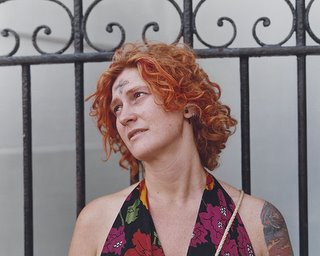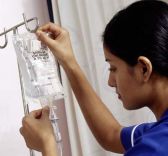
Today is Ash Wednesday, the first day of Lent – although I’ve known all along that I would not be participating in our church’s Ash Wednesday service. We have a tradition here, now several years old, of having a simple, penitential meal of soup and bread in our church hall, followed by the sacrament of the Lord’s Supper. We also offer the imposition of ashes for those who wish to receive this sign – an idea I brought to this church, and which at first seemed strange to our people (“too Catholic,” some thought), but which has really caught on.
The reason I knew I would not be present for the Ash Wednesday service is that today is also – by a quirk of the calendar – the day of my third chemotherapy treatment. At the end of the three-week recovery period following this treatment, I’ll be halfway through my chemo experience.
 My trip to Dr. Lerner’s office now seems almost routine (something I could hardly have imagined would be possible on the day of my first treatment). I guess you can get used to anything. Claire drives me in, and sits in the waiting room while I’m ushered back into the Nurses’ Room for the tapping into my porta-cath. I remind them to use a large needle to reach this deeply-implanted device, so there’s no repeat of the uncomfortable trial-and-error process of last time. Diane, the nurse who’s doing this for me, is very skilled, and the pain is no worse than getting a blood draw. It’s brief, and over in an instant. Then, she flushes the porta-cath and draws a blood sample through it for my weekly CBC (complete blood count), before directing me into one of the examining rooms.
My trip to Dr. Lerner’s office now seems almost routine (something I could hardly have imagined would be possible on the day of my first treatment). I guess you can get used to anything. Claire drives me in, and sits in the waiting room while I’m ushered back into the Nurses’ Room for the tapping into my porta-cath. I remind them to use a large needle to reach this deeply-implanted device, so there’s no repeat of the uncomfortable trial-and-error process of last time. Diane, the nurse who’s doing this for me, is very skilled, and the pain is no worse than getting a blood draw. It’s brief, and over in an instant. Then, she flushes the porta-cath and draws a blood sample through it for my weekly CBC (complete blood count), before directing me into one of the examining rooms.Claire joins me there, and we meet with Dr. Lerner. Nothing new here – a cursory physical exam, some questions about how I’m doing, and a review of my charts. He writes a prescription for a CT scan in a couple of weeks – this being my third chemo treatment of six, it’s time for a mid-course check on what’s happening to my abdominal tumors. I ask Dr. Lerner how often these CT scans result in a mid-course change in the treatment protocol, and he says not often – only if “there’s a significant change for the worse,” meaning that the tumors are growing rather than shrinking. The fact that he doesn’t have to make these mid-course corrections very often is reassuring.
 It’s back to the treatment area after this. I take my place in the same little room where I was for my last two treatments. I relax in the lounge chair, Vanessa starts me on the anti-nausea drug Aloxi, then brings in another bag filled with Benadryl (which always accompanies the chemo treatments). No sooner does the Benadryl start going than – BAM! – my eyelids start drooping and I fall asleep for two and a half hours. I awake feeling flushed and sweaty from the Rituxan, but not so much this time that I need to ask them to slow it down. Feeling grateful for the unexpected nap, I make the first of many trips down the hall to the rest room, pushing the IV pole-on-wheels ahead of me (several of the chemo drugs are bladder irritants, so this ungainly procession is a familiar part of the routine). As soon as I unplug the IV pump from the electrical socket on the wall, the thing switches to battery power and starts beeping a warning signal, so I feel conspicuous as I walk past the other patients’ treatment rooms, especially after the fourth or fifth trip of the afternoon. Oh well, we’re all this together.
It’s back to the treatment area after this. I take my place in the same little room where I was for my last two treatments. I relax in the lounge chair, Vanessa starts me on the anti-nausea drug Aloxi, then brings in another bag filled with Benadryl (which always accompanies the chemo treatments). No sooner does the Benadryl start going than – BAM! – my eyelids start drooping and I fall asleep for two and a half hours. I awake feeling flushed and sweaty from the Rituxan, but not so much this time that I need to ask them to slow it down. Feeling grateful for the unexpected nap, I make the first of many trips down the hall to the rest room, pushing the IV pole-on-wheels ahead of me (several of the chemo drugs are bladder irritants, so this ungainly procession is a familiar part of the routine). As soon as I unplug the IV pump from the electrical socket on the wall, the thing switches to battery power and starts beeping a warning signal, so I feel conspicuous as I walk past the other patients’ treatment rooms, especially after the fourth or fifth trip of the afternoon. Oh well, we’re all this together.It’s all over by about 4:30 – six hours this time, a record. Claire has arrived a few minutes earlier, so we drive home. I sit on the couch and eat a little supper (again provided by one of our church members - Yay!), despite the queasy feelings I’m beginning to experience. We can hear the comings and goings of people next door in the church’s Education Annex, as the Ash Wednesday soup supper and service is beginning.
It feels odd not to be there. Claire has some ashes left over from her hospice chaplain work today, so we mark each other’s foreheads with them. Somehow, it’s hard to utter the traditional words, “Remember that you are dust, and to dust you shall return,” so we just let the ashes speak for themselves. Neither of us needs much reminding of our mortality after a day of chemotherapy, but the ritual is comforting, all the same.
